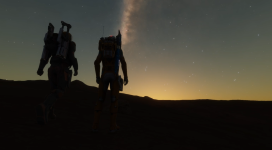You are using an out of date browser. It may not display this or other websites correctly.
You should upgrade or use an alternative browser.
You should upgrade or use an alternative browser.
Horizons Planet showcase - post your most beautiful shots that you are really proud of
- Thread starter The Law
- Start date
It looks like you are steaming like a geyser.My fav pic.
I think it is actually possible. Although I think it is unlikely to occur, it looks like once it did occur, it would be pretty stable.Impossible planet configuration, but nice view...
(Also the proximity would make both moons quite ellipsoidal, sorta-melon-shaped one might say, although it would not be very visible from this perspective.)
They would tear each other apart at this distance and become an orbiting debris cloud, eventually another ring of the giant.I think it is actually possible. Although I think it is unlikely to occur, it looks like once it did occur, it would be pretty stable.
(Also the proximity would make both moons quite ellipsoidal, sorta-melon-shaped one might say, although it would not be very visible from this perspective.)
How high is the gravity on these moons? Most moons I have visited so far have not enough power to tear another body apart.They would tear each other apart at this distance and become an orbiting debris cloud, eventually another ring of the giant.
That gas giant, though...
I don’t think so. If both moons have similar masses (which is probably the case), they can be very close together without one destroying the other — although, as I said, the gravitational gradients would deform them. This is conceptually not different from very close binary stars like the Beta Lyrae primary pair.They would tear each other apart at this distance and become an orbiting debris cloud, eventually another ring of the giant.
(BTW, all Roche limit formulae I could find are derived with the assumption that m≪M and/or r≪R.)
An icy moon 2000 km across (i.e. radius = 1000 km, quite typical for ED) surely has enough mass to disrupt a smaller, say Enceladus-sized (radius ≈ 250 km), icy moon if the latter came well within its Roche limit for a sufficiently long time. Their gravity may be weak, but the effects scale with the size and accumulate over time — that is what makes those moons’ shapes roughly spherical. (Incidentally, very small, irregularly-shaped moons tend to be more difficult to disrupt because they are held together by tensile strength more than by gravity; that’s how there can be a few of them inside Saturn’s rings.)How high is the gravity on these moons? Most moons I have visited so far have not enough power to tear another body apart.
That gas giant, though...
However, what we have in that picture is certainly two similarly-sized moons, so the actual Roche limit is likely to be less than the distance between them.
The gas giant, OTOH, appears to be at a safe distance.
Which seems to be quite common in ED. I have seen quite a few in a limited space - Haven't managed to leave the bubble, yet, let alone visited all of it. 4 engineers and their surroundings as well as some stars in between, that's all so far.However, what we have in that picture is certainly two similarly-sized moons, so the actual Roche limit is likely to be less than the distance between them.
I love this angle. It's one of my favorites for planet screenshots, because we get to feature the boat that brought us there too.
Last edited:








